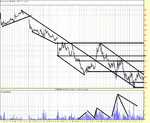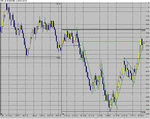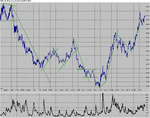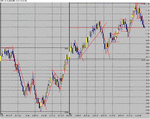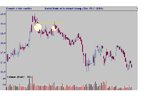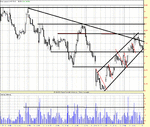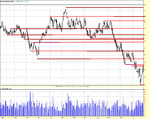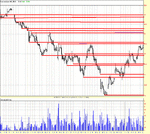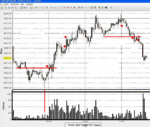Weekend reflection
Master the Four Fears of Trading
November 2002
Originally Published
in Stock Futures and Options Magazine
by: Price Headley
Merriam-Webster's dictionary defines fear as "an unpleasant, often strong emotion caused by anticipation or awareness of danger, going on to explain that fear...implies anxiety and usually the loss of courage." This definition of fear is useful in helping define the issues that traders face when coping with fear. The reality is that all traders feel fear at some level, but the key is how we prepare to address our concerns related to taking on risk as a trader. In this article I will review four major fears experienced by traders, and I'll take it a step further by noting how the outcomes of these fears create undesirable trading behaviors. Basically, my aim is to have you walk away with an understanding of these dangers so you can and implement strategies that will address your fears and let you get on with your trading plan.
Mark Douglas, an expert in trading psychology, noted in his book, Trading in the Zone, that most investors believe they know what is going to happen next. This causes traders to put too much weight on the outcome of the current trade, while not assessing their performance as "a probability game" that they are playing over time. This manifests itself in investors getting too high and too low and causes them to react emotionally, with excessive fear or greed after a series of losses or wins.
As the importance of an individual trade increases in the trader's mind, the fear level tends to increase as well. A trader becomes more hesitant and cautious, seeking to avoid a mistake. The risk of choking under pressure increases as the trader feels the pressure build.
All traders have fear, but winning traders manage their fear while losers are controlled by it. When faced with a potentially dangerous situation, the instinctive tendency is to revert to the "fight or flight" response. We can either prepare to do battle against the perceived threat, or we can flee from this danger. When an investor interprets a state of arousal negatively as fear or stress, performance is likely to be impaired. A trader will tend to ?freeze.? In contrast, when a trader feels the surge of adrenaline but interprets this as excitement or a state of greater alertness before placing a trade, then performance will tend to improve. Many great live performers talk of feeling butterflies just before they go on stage, and how they interpret this as a wake-up call to go out and perform at their highest level. That's clearly a more empowering response than someone who might interpret these butterflies as a reason to run back to his dressing room to get sick! Winners take positive action in spite of their fears.
1. Fear of Loss
Analysis Paralysis and Its Cousins
The fear of losing when making a trade often has several consequences. Fear of loss tends to make a trader hesitant to execute his trading plan. This can often lead to an inability to pull the trigger on new entries as well as on new exits. As a trader, you know that you need to be decisive in taking action when your approach dictates a new entry or exit, so when fear of loss holds you back from taking action, you also lose confidence in your ability to execute your trading plan. This causes a lack of trust in your method or,more importantly, in your own ability to execute future trades.
Thus, you can see how fear can set in place a vicious cycle of recurring doubt and, in turn, reinforce a traders' lack of confidence in executing new positions. For example, if you doubt you will actually be able to exit your position when your method tells you to get the heck out, then as a self-preservation mechanism you will also choose not to get into new trades. Thus begins the analysis paralysis, where you are merely looking at new trades but not getting the proper reinforcement to pull the trigger. In fact, the reinforcement is negative and actually pulls you away from making a move.
Looking deeper at why a trader cannot pull the trigger, I believe the root stems from a lack of confidence about the trading plan, which then causes the trader to believe that by not trading, he is moving away from potential pain as opposed to moving toward future gain. No one likes losses, but the reality is, of course, that even the best professionals will lose. The key is that they will lose much less, which allows them to remain in the game both financially and psychologically. The longer you can remain in the trading game with a sound method, the more likely you will start to experience a better run of trades that will take you out of any temporary trading slumps.
When you're having trouble pulling the trigger, realize that you are worrying too much about results and are not focused on your execution process. Make sure your have a written plan and then practice executing your plan.
Start with paper trades if you prefer, or consider trading smaller positions to get the fear of losing out of your system and get yourself focused on execution. When in the heat of battle and realizing you need to get in or out of a trade, consider using market orders, especially on the exit. That way you can't beat yourself up for not pulling the trigger on your trade.
Many traders may get too cute with a trade and try to work out of a position at a limit price better than the current market price, hoping they can squeeze more out of a trade. But as famed trader Jesse Livermore advised in the classic book Reminiscences of a Stock Operator by Edwin Lefevre, ?give up trying to catch the last eighth.? Keep it simple with a market order to exit allows you to bring closure when you need it, which reinforces the confidence-building feelings that come from following your trading plan. In the past when my indicators noted it was time to exit, I have experienced firsthand the pain of not getting filled at my limit, watching the option drop and then placing a new limit back where I should have exited at the market in the first place! Then I have realized I was not going to get filled there either, so I again kept lowering my limit until, in frustration, I placed a market order to exit much lower than I could have closed the position initially. Not only can you feel the pain of loss financially but, more important, you can chip away at your internal state of confidence and create frustration by not getting filled.
You should be more concerned about avoiding big losses and less concerned about taking small losses. If you can?t bear to take a small loss, you will never give yourself an opportunity to be around when a big winning idea comes along, as every trade you enter has the risk of first turning against you for a loss. You must execute by knowing what your risk is in each trade, and define parameters to make sure you can ride favorable trends correctly as well so that your winners will be larger than you losers. And never get stuck in the mindset of hoping a loser will come back to "breakeven," as that is one of the trader's most deadly mental fantasies. Billions of dollars have been lost by technology investors hoping their stocks would bounce back in recent years to allow them to escape the downtrend. That only led to even greater losses in most cases. That's how a short-term trader can become a long-term investor unintentionally, and that is a position in which you never want to put yourself.
Ask how well you trust yourself to execute your trading plan. You want to judge your effectiveness based on how well you get in and out of the market when your method gives entry and exit signals. You?ll need to be decisive, not hesitant, know in your heart that your method is well tested and that your risk is low compared to your likely reward. In other words, you must be fully prepared before you go into the heat of battle during a trading day. You need to know where you will enter and where you will exit if you are a discretionary trader. Or you need to know what system you are following and be prepared to enter and exit as the system dictates. This keeps you disciplined and focused on following a process that can generate favorable results over time.
2. Fear of Missing Out
Being a Part of the Crowd Isn?t
Everything It's Cracked Up to Be
Every trend always has its doubters, but I often notice that many skeptics of a trend will slowly become converts due to the fear of missing out on profits or the pain of losses in betting against that trend. The fear of missing out can also be characterized as greed of a sorts, for an investor is not acting based on some desire to own the security - other than the fact that it is going up without him on board. This fear is often fueled during runaway booms like the technology bubble of the late-1990s, as investors heard their friends talking about newfound riches. The fear of missing out came into play for those who wanted to experience the same type of euphoria.
When you think about it, this is a very dangerous situation, as at this stage investors tend essentially to say, "Get me in at any price - I must participate in this hot trend!? The effect of the fear of missing out is a blindness to any potential downside risk, as it seems clear to the investor that there can only be gains ahead from such a "promising" and "obviously beneficial" trend. But there's nothing obvious about it.
We remember the stories of the Internet and how it would revolutionize the way business was done. While the Internet has indeed had a significant impact on our lives, the hype and frenzy for these stocks ramped up supply of every possible technology stock that could be brought public and created a situation where the incredibly high expectations could not possibly be met in reality. It is expectation gaps like this that often create serious risks for those who have piled into a trend late, once it has been widely broadcast in the media to all investors.
3. Fear of Letting a Profit Turn into a Loss
I get many more questions from subscribers asking if it is time to take a profit than I do subscribers asking when they should take their loss. This represents the fact that most traders do the opposite of the "let profits run, cut losses short" motto: they instead like to take quick profits while letting losers get out of control. Why would a trader do this? Too many traders tend to equate their net worth with their self-worth. They want to lock in a quick profit to guarantee that they feel like a winner.
How should you take profits? Should you utilize a fixed target profit objective, or should you only trail your stop on a winning trade until the trend breaks?
Those who can accept more risk should consider trailing a stop on their trending position, while more conservative traders may be more comfortable taking profits at their target objective. There is another alternative as well, which is to merge the two concepts by taking some profits off the table while seeking to ride the trend with a trailing stop on the remaining portion of the position.
When I trade options, I usually recommend taking half of the position off at a double or more, and then following the half position still open with a trailing stop. This allows you to have the opportunity to ride my best trading ideas further, as these are the trades where I am mostly likely to continue being right. Yet, I am also able to get the initial capital at risk back in my pocket, which frees me from worrying about letting a profit turn into a loss; I am guaranteed a breakeven even if the other half position were to go to nothing overnight. My general rule for the remaining half position is to exit if it reaches my trailing stop of half its maximum profit on an end-of-day closing basis, or scale out of the remaining half position every time it doubles again.
I?m also a big fan of moving your stop up to breakeven relatively quickly once the position starts to move in your favor, by about five percent on a stock or by roughly 25 percent on the option. It is also critical to recognize the impact of time spent waiting for a position to move. If you are not losing but not yet winning after several trading days, there are likely better opportunities elsewhere. This is known as a "time stop," and it will get your capital out of non-performers and free it up for fresher trading ideas.
4. Fear of Not Being Right - All Too Common
Too many traders care too much about being proven right in their analysis on each trade, as opposed to looking at trading as a probability game in which they will be both right and wrong on individual trades. In other words, their overall method will create positive results.
The desire to focus on being right instead of making money is a function of the individual's ego, and to be successful you must trade without ego at all costs. Ego leads to equating the trader?s net worth with his self-worth, which results in the desire to take winners too quickly and sit on losers in often-misguided hopes of exiting at a breakeven.
Trading results are often a mirror for where you are in your life. If you feel any sort of conflict internally with making money or feel the need to be perfect in everything you do, you will experience cognitive dissonance as you trade. This means that your brain will be insisting that you cannot exit a trade at a loss because it ruins your self-image of perfection. Or if you grew up and feel guilty about having money, your mind and ego will find a way to give up gains and take losses in the markets. The ego?s need to protect its version of the self must be let go in order to rid ourselves of the potential for self-sabotage.
If you have a perfectionist mentality when trading, you are really setting yourself up for failure, because it is a given that you will experience losses along the way in trading. Again, you have to think of trading as a probability game. You can't be a perfectionist and expect to be a great trader. If you cannot take a loss when it is small because of the need to be perfect, then the loss will often times grow to a much larger loss, causing further pain for the perfectionist. The objective should be excellence in trading, not perfection.
In addition, you should strive for excellence over a sustained period, as opposed to judging that each trade must be excellent. The great traders make mistakes too, but they are able to keep the impact of those mistakes small, while really riding their best ideas fully.
For the trader who is dealing with excessive ego challenges (yet, who wants to admit it?), this is one of the strongest arguments for mechanical systems, as you grade yourself not on whether your trade analysis was right or wrong. Instead you judge yourself based on how effectively you executed your system?s entry and exit signals. This is much easier for those traders who want to leave their egos at the door when they start to trade. Additionally, because we are raised in a highly competitive culture, the perception of a contest or competition will also bring out your ego's desire to win and beat others.
You will be better off seeing trading as a series of opportunities that will become apparent to you, and your task is to create a plan that finds opportunities with potential rewards that are several times greater than the risks you incur.
Be sure you are writing down your reasons for entering each trade, as the ego will play tricks and come up with new reasons to hang on to losing positions once the original reasons have evaporated. One of our survival mechanisms is remembering the good and omitting the bad in our minds, but this is dangerous in trading. You must acknowledge the risk and use a stop on every trade to admit when the analysis is no longer timely. This helps prevent undesirable situations where you get stuck in a position because you did not adhere to your original stop. This is a bad use of capital being tied up in an under-performing position, when there are likely to be many better opportunities elsewhere. Trading without stops is an ego-driven approach that hopes to avoid accountability for a losing trading idea. This is an unacceptable behavior to the successful trader, who knows he must limit risk with stops to stay in the game for the next trading opportunity.
In summary, your trading plan must account for the emotions you will be prone to experience, particularly those related to managing fear. As a trade, you must move from a fearful mindset to mental state of confidence. You have to believe in your ability as well as the effectiveness of your plan to take profits that are larger than the manageable losses. This builds the confidence of knowing that you are on the right track. It also makes it easier to continue to execute new trades after a string of losing positions. Psychologically, that's the critical point where many individuals will pull the plug, because they are too reactive to emotions as opposed to the longer-term mechanics of their plan. If you?re not sure if you can make this leap, know that you can if you start small.
Too many investors have an "all-or-none" mentality. They're either going to get rich quick or blow out trying. You want to take the opposite mentality - one that signals that you are in this for the longer haul. This gives you "permission" to slowly get comfortable and to keep refining your plan as you go. As you focus on execution while managing fear, you realize that giving up is the only way you can truly lose. You will win as you conquer the four major fears, to gain confidence in your trading method and, ultimately, you will gain even more confidence in yourself.
Master the Four Fears of Trading
November 2002
Originally Published
in Stock Futures and Options Magazine
by: Price Headley
Merriam-Webster's dictionary defines fear as "an unpleasant, often strong emotion caused by anticipation or awareness of danger, going on to explain that fear...implies anxiety and usually the loss of courage." This definition of fear is useful in helping define the issues that traders face when coping with fear. The reality is that all traders feel fear at some level, but the key is how we prepare to address our concerns related to taking on risk as a trader. In this article I will review four major fears experienced by traders, and I'll take it a step further by noting how the outcomes of these fears create undesirable trading behaviors. Basically, my aim is to have you walk away with an understanding of these dangers so you can and implement strategies that will address your fears and let you get on with your trading plan.
Mark Douglas, an expert in trading psychology, noted in his book, Trading in the Zone, that most investors believe they know what is going to happen next. This causes traders to put too much weight on the outcome of the current trade, while not assessing their performance as "a probability game" that they are playing over time. This manifests itself in investors getting too high and too low and causes them to react emotionally, with excessive fear or greed after a series of losses or wins.
As the importance of an individual trade increases in the trader's mind, the fear level tends to increase as well. A trader becomes more hesitant and cautious, seeking to avoid a mistake. The risk of choking under pressure increases as the trader feels the pressure build.
All traders have fear, but winning traders manage their fear while losers are controlled by it. When faced with a potentially dangerous situation, the instinctive tendency is to revert to the "fight or flight" response. We can either prepare to do battle against the perceived threat, or we can flee from this danger. When an investor interprets a state of arousal negatively as fear or stress, performance is likely to be impaired. A trader will tend to ?freeze.? In contrast, when a trader feels the surge of adrenaline but interprets this as excitement or a state of greater alertness before placing a trade, then performance will tend to improve. Many great live performers talk of feeling butterflies just before they go on stage, and how they interpret this as a wake-up call to go out and perform at their highest level. That's clearly a more empowering response than someone who might interpret these butterflies as a reason to run back to his dressing room to get sick! Winners take positive action in spite of their fears.
1. Fear of Loss
Analysis Paralysis and Its Cousins
The fear of losing when making a trade often has several consequences. Fear of loss tends to make a trader hesitant to execute his trading plan. This can often lead to an inability to pull the trigger on new entries as well as on new exits. As a trader, you know that you need to be decisive in taking action when your approach dictates a new entry or exit, so when fear of loss holds you back from taking action, you also lose confidence in your ability to execute your trading plan. This causes a lack of trust in your method or,more importantly, in your own ability to execute future trades.
Thus, you can see how fear can set in place a vicious cycle of recurring doubt and, in turn, reinforce a traders' lack of confidence in executing new positions. For example, if you doubt you will actually be able to exit your position when your method tells you to get the heck out, then as a self-preservation mechanism you will also choose not to get into new trades. Thus begins the analysis paralysis, where you are merely looking at new trades but not getting the proper reinforcement to pull the trigger. In fact, the reinforcement is negative and actually pulls you away from making a move.
Looking deeper at why a trader cannot pull the trigger, I believe the root stems from a lack of confidence about the trading plan, which then causes the trader to believe that by not trading, he is moving away from potential pain as opposed to moving toward future gain. No one likes losses, but the reality is, of course, that even the best professionals will lose. The key is that they will lose much less, which allows them to remain in the game both financially and psychologically. The longer you can remain in the trading game with a sound method, the more likely you will start to experience a better run of trades that will take you out of any temporary trading slumps.
When you're having trouble pulling the trigger, realize that you are worrying too much about results and are not focused on your execution process. Make sure your have a written plan and then practice executing your plan.
Start with paper trades if you prefer, or consider trading smaller positions to get the fear of losing out of your system and get yourself focused on execution. When in the heat of battle and realizing you need to get in or out of a trade, consider using market orders, especially on the exit. That way you can't beat yourself up for not pulling the trigger on your trade.
Many traders may get too cute with a trade and try to work out of a position at a limit price better than the current market price, hoping they can squeeze more out of a trade. But as famed trader Jesse Livermore advised in the classic book Reminiscences of a Stock Operator by Edwin Lefevre, ?give up trying to catch the last eighth.? Keep it simple with a market order to exit allows you to bring closure when you need it, which reinforces the confidence-building feelings that come from following your trading plan. In the past when my indicators noted it was time to exit, I have experienced firsthand the pain of not getting filled at my limit, watching the option drop and then placing a new limit back where I should have exited at the market in the first place! Then I have realized I was not going to get filled there either, so I again kept lowering my limit until, in frustration, I placed a market order to exit much lower than I could have closed the position initially. Not only can you feel the pain of loss financially but, more important, you can chip away at your internal state of confidence and create frustration by not getting filled.
You should be more concerned about avoiding big losses and less concerned about taking small losses. If you can?t bear to take a small loss, you will never give yourself an opportunity to be around when a big winning idea comes along, as every trade you enter has the risk of first turning against you for a loss. You must execute by knowing what your risk is in each trade, and define parameters to make sure you can ride favorable trends correctly as well so that your winners will be larger than you losers. And never get stuck in the mindset of hoping a loser will come back to "breakeven," as that is one of the trader's most deadly mental fantasies. Billions of dollars have been lost by technology investors hoping their stocks would bounce back in recent years to allow them to escape the downtrend. That only led to even greater losses in most cases. That's how a short-term trader can become a long-term investor unintentionally, and that is a position in which you never want to put yourself.
Ask how well you trust yourself to execute your trading plan. You want to judge your effectiveness based on how well you get in and out of the market when your method gives entry and exit signals. You?ll need to be decisive, not hesitant, know in your heart that your method is well tested and that your risk is low compared to your likely reward. In other words, you must be fully prepared before you go into the heat of battle during a trading day. You need to know where you will enter and where you will exit if you are a discretionary trader. Or you need to know what system you are following and be prepared to enter and exit as the system dictates. This keeps you disciplined and focused on following a process that can generate favorable results over time.
2. Fear of Missing Out
Being a Part of the Crowd Isn?t
Everything It's Cracked Up to Be
Every trend always has its doubters, but I often notice that many skeptics of a trend will slowly become converts due to the fear of missing out on profits or the pain of losses in betting against that trend. The fear of missing out can also be characterized as greed of a sorts, for an investor is not acting based on some desire to own the security - other than the fact that it is going up without him on board. This fear is often fueled during runaway booms like the technology bubble of the late-1990s, as investors heard their friends talking about newfound riches. The fear of missing out came into play for those who wanted to experience the same type of euphoria.
When you think about it, this is a very dangerous situation, as at this stage investors tend essentially to say, "Get me in at any price - I must participate in this hot trend!? The effect of the fear of missing out is a blindness to any potential downside risk, as it seems clear to the investor that there can only be gains ahead from such a "promising" and "obviously beneficial" trend. But there's nothing obvious about it.
We remember the stories of the Internet and how it would revolutionize the way business was done. While the Internet has indeed had a significant impact on our lives, the hype and frenzy for these stocks ramped up supply of every possible technology stock that could be brought public and created a situation where the incredibly high expectations could not possibly be met in reality. It is expectation gaps like this that often create serious risks for those who have piled into a trend late, once it has been widely broadcast in the media to all investors.
3. Fear of Letting a Profit Turn into a Loss
I get many more questions from subscribers asking if it is time to take a profit than I do subscribers asking when they should take their loss. This represents the fact that most traders do the opposite of the "let profits run, cut losses short" motto: they instead like to take quick profits while letting losers get out of control. Why would a trader do this? Too many traders tend to equate their net worth with their self-worth. They want to lock in a quick profit to guarantee that they feel like a winner.
How should you take profits? Should you utilize a fixed target profit objective, or should you only trail your stop on a winning trade until the trend breaks?
Those who can accept more risk should consider trailing a stop on their trending position, while more conservative traders may be more comfortable taking profits at their target objective. There is another alternative as well, which is to merge the two concepts by taking some profits off the table while seeking to ride the trend with a trailing stop on the remaining portion of the position.
When I trade options, I usually recommend taking half of the position off at a double or more, and then following the half position still open with a trailing stop. This allows you to have the opportunity to ride my best trading ideas further, as these are the trades where I am mostly likely to continue being right. Yet, I am also able to get the initial capital at risk back in my pocket, which frees me from worrying about letting a profit turn into a loss; I am guaranteed a breakeven even if the other half position were to go to nothing overnight. My general rule for the remaining half position is to exit if it reaches my trailing stop of half its maximum profit on an end-of-day closing basis, or scale out of the remaining half position every time it doubles again.
I?m also a big fan of moving your stop up to breakeven relatively quickly once the position starts to move in your favor, by about five percent on a stock or by roughly 25 percent on the option. It is also critical to recognize the impact of time spent waiting for a position to move. If you are not losing but not yet winning after several trading days, there are likely better opportunities elsewhere. This is known as a "time stop," and it will get your capital out of non-performers and free it up for fresher trading ideas.
4. Fear of Not Being Right - All Too Common
Too many traders care too much about being proven right in their analysis on each trade, as opposed to looking at trading as a probability game in which they will be both right and wrong on individual trades. In other words, their overall method will create positive results.
The desire to focus on being right instead of making money is a function of the individual's ego, and to be successful you must trade without ego at all costs. Ego leads to equating the trader?s net worth with his self-worth, which results in the desire to take winners too quickly and sit on losers in often-misguided hopes of exiting at a breakeven.
Trading results are often a mirror for where you are in your life. If you feel any sort of conflict internally with making money or feel the need to be perfect in everything you do, you will experience cognitive dissonance as you trade. This means that your brain will be insisting that you cannot exit a trade at a loss because it ruins your self-image of perfection. Or if you grew up and feel guilty about having money, your mind and ego will find a way to give up gains and take losses in the markets. The ego?s need to protect its version of the self must be let go in order to rid ourselves of the potential for self-sabotage.
If you have a perfectionist mentality when trading, you are really setting yourself up for failure, because it is a given that you will experience losses along the way in trading. Again, you have to think of trading as a probability game. You can't be a perfectionist and expect to be a great trader. If you cannot take a loss when it is small because of the need to be perfect, then the loss will often times grow to a much larger loss, causing further pain for the perfectionist. The objective should be excellence in trading, not perfection.
In addition, you should strive for excellence over a sustained period, as opposed to judging that each trade must be excellent. The great traders make mistakes too, but they are able to keep the impact of those mistakes small, while really riding their best ideas fully.
For the trader who is dealing with excessive ego challenges (yet, who wants to admit it?), this is one of the strongest arguments for mechanical systems, as you grade yourself not on whether your trade analysis was right or wrong. Instead you judge yourself based on how effectively you executed your system?s entry and exit signals. This is much easier for those traders who want to leave their egos at the door when they start to trade. Additionally, because we are raised in a highly competitive culture, the perception of a contest or competition will also bring out your ego's desire to win and beat others.
You will be better off seeing trading as a series of opportunities that will become apparent to you, and your task is to create a plan that finds opportunities with potential rewards that are several times greater than the risks you incur.
Be sure you are writing down your reasons for entering each trade, as the ego will play tricks and come up with new reasons to hang on to losing positions once the original reasons have evaporated. One of our survival mechanisms is remembering the good and omitting the bad in our minds, but this is dangerous in trading. You must acknowledge the risk and use a stop on every trade to admit when the analysis is no longer timely. This helps prevent undesirable situations where you get stuck in a position because you did not adhere to your original stop. This is a bad use of capital being tied up in an under-performing position, when there are likely to be many better opportunities elsewhere. Trading without stops is an ego-driven approach that hopes to avoid accountability for a losing trading idea. This is an unacceptable behavior to the successful trader, who knows he must limit risk with stops to stay in the game for the next trading opportunity.
In summary, your trading plan must account for the emotions you will be prone to experience, particularly those related to managing fear. As a trade, you must move from a fearful mindset to mental state of confidence. You have to believe in your ability as well as the effectiveness of your plan to take profits that are larger than the manageable losses. This builds the confidence of knowing that you are on the right track. It also makes it easier to continue to execute new trades after a string of losing positions. Psychologically, that's the critical point where many individuals will pull the plug, because they are too reactive to emotions as opposed to the longer-term mechanics of their plan. If you?re not sure if you can make this leap, know that you can if you start small.
Too many investors have an "all-or-none" mentality. They're either going to get rich quick or blow out trying. You want to take the opposite mentality - one that signals that you are in this for the longer haul. This gives you "permission" to slowly get comfortable and to keep refining your plan as you go. As you focus on execution while managing fear, you realize that giving up is the only way you can truly lose. You will win as you conquer the four major fears, to gain confidence in your trading method and, ultimately, you will gain even more confidence in yourself.

